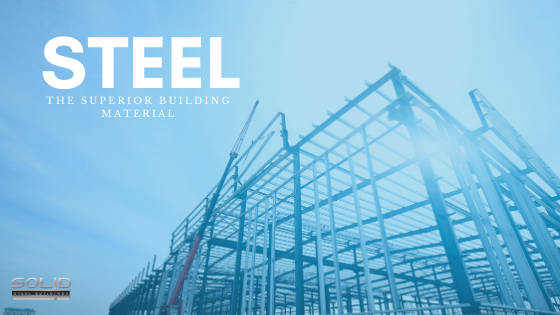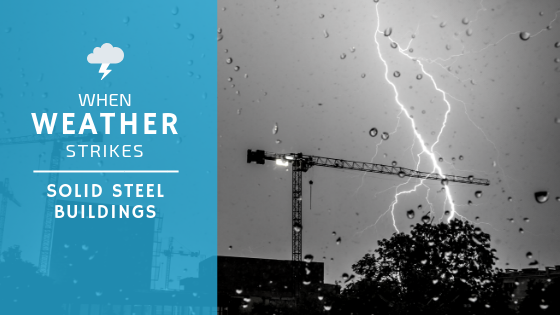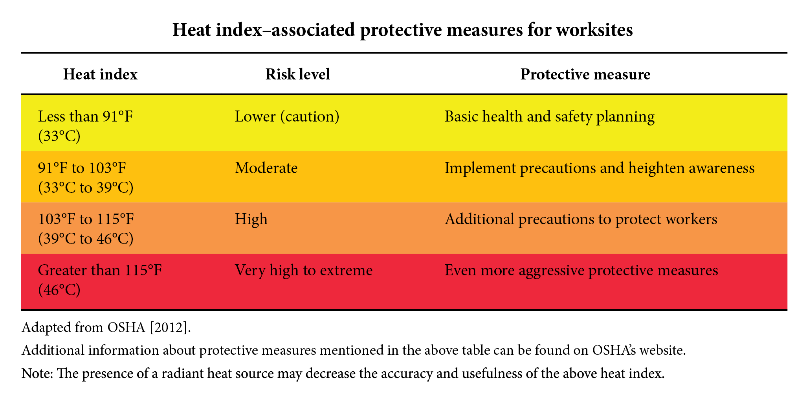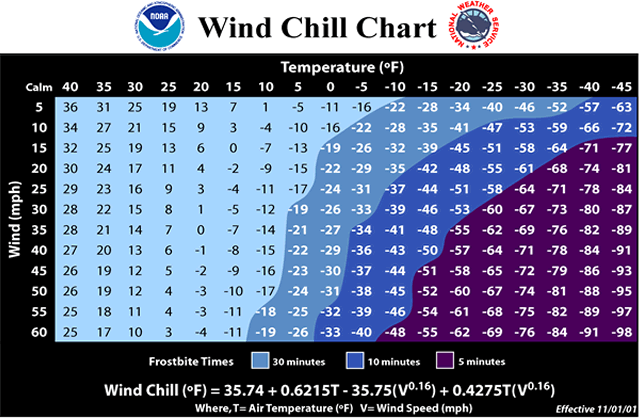Steel: The Superior Building Material

When it comes to choosing what material to use for your building, the number of options available can be daunting. Some folks believe in wood, others block, but when it comes to the ultimate in durability, longevity and economy of scale, building out of steel trumps them all. Architecturally speaking, steel offers almost unlimited options for design and tailoring a structure to your exact needs, and without the need for interior columns in most cases, building with steel maximizes interior space like no other.
Steel is one of the strongest materials available and is almost 100% impervious to degradation if designed and erected with the proper means. Galvanized steel will not corrode like other materials and can be trusted to outperform decades longer than wood or block. Recent advances in engineering methods assure that steel structures are built to exacting specifications, taking the guesswork out of construction in the field and avoiding hazardous issues and mistakes long before construction even begins.
With the available upgrades to a steel structure such as insulated metal panels, steel mezzanines, solid door and window systems and the like, a steel building is highly customizable allowing for security along with form and function at the same time. The foundation systems used in steel buildings can be designed to make the best of the most challenging site situations, allowing for maximum cost savings over traditional construction methods in less time. Also keep in mind the maintenance of a steel building, with the correct insulation package and basic upkeep, a steel structure allows you to focus on what you built the building for in the first place without having to think about ongoing costly maintenance issues.
At Solid Steel Buildings no project is to big or too small, we have the knowledge and time-tested ability to design a building that is perfectly suited to your needs be it a backyard workshop or a large facility for manufacturing and everything in between. Call us today to discover why steel is the superior building material and let’s get building!
Wind Frame Bracing 101: From Basics to the Secrets
How do you protect your steel building against wind, snow, collateral, and seismic forces? In short — wind frame bracing. The main structural elements of any steel building are the main columns, wall girts, and roof purlins. These members make up the “skeleton” of your building by supporting the roof and wall panels, giving structural integrity, and helping to allow for a water tight seal.
Let’s think about the dynamic forces in play that act upon your building. Think of a house of cards, built with sides and a roof, but no interior structural support. Now think of how easy it is for a house of cards to topple over. This is where wind framing comes into play. Without wind framing members, your building would be at the mercy of wind and seismic forces — allowing the building to sway and flex — ultimately causing a catastrophic failure of the structure.
Typical wind framing consists of an “X” pattern of either cable bracing or rod bracing, depending on your geographical location. These braces are placed every 100’ across the length of your building, on average. Alternatively, they are placed every fourth or fifth bay (depending if your bays are spaced at 20’ intervals or 25’ intervals) on the walls and roof evenly.
Your Bracing Options
Cable bracing is the less expensive option, but will require re-tightening every 3 to 5 years. However, almost no one takes this factor into account, which can lead to less overall stability of the structure over time.
Rod bracing, on the other hand, is as you might imagine — more rigid, with zero stretch, and stronger than cable bracing without the need for re-tightening. This makes for a more stable structure over time for only a few hundred dollars more per structure. At Solid Steel Buildings, we rarely implement cable bracing because we believe in giving our clients a maintenance free building that can withstand rigors across multiple environments and building codes.
The final bracing type is called portal bracing. This type of bracing is utilized when an opening — such as a garage door, window, or walk door — must be in a bay where wind bracing is required by engineering standard. Portal bracing is essentially two vertical steel members welded to the vertical columns, with a horizontal header member attached to the vertical members spanning across the top of your framed opening. Portal frames allow for flexibility in placement of framed openings; however, each portal frame costs a few hundred dollars more than regular “X” bracing. Flexibility is the key with your building design, so portal frames are a good choice when control over ingress and egress locations are of absolute importance.
Obviously, the engineering and science behind steel building loading is far more in-depth than we can discuss in this month’s blog. Rest assured that your Solid Steel Building team is proficient in engineering practices to ensure your building is able to withstand the rigors of your geographical location — ensuring a worry-free structure for years and years of service. Contact your Solid Steel Building Representative today and let’s get building together!
Insulation: Do’s & Dont’s For Your Steel Building
 Today’s blog topic will focus on Steel Buildings 101, an often overlooked component of a building envelope, yet one of the most important considerations when planning your overall project, a part of the puzzle, that if done right will pay dividends down the road, or lead to conditions in the building that will wish you had planned better.
Today’s blog topic will focus on Steel Buildings 101, an often overlooked component of a building envelope, yet one of the most important considerations when planning your overall project, a part of the puzzle, that if done right will pay dividends down the road, or lead to conditions in the building that will wish you had planned better.
Insulation… it keeps us warm, it keeps us cool, but how much do we ever really think about this stuff when pricing out our buildings, especially in the beginning stages of discovery.
Insulation and Your Steel Building
We all know what insulation does, we know what it’s made of, but how does it relate to a steel structure?
One of the mistakes 1st time builders and customers make is to not account for the correct type of insulation for their needs. What part of the country / world are you building? What type of climate control do you need for the activities inside your structure? How comfortable do you need to be? What are the local building codes requiring?
All good questions. At a minimum, it is wise to know that a steel structure insulation needs to be correctly sized for the roof system being implemented. For example: If you are going with a screw down roof, an R-19 or 6’’ batt insulation system can suffice, depending on your needs and local building codes. A simple R-19 system is good at deflecting heat of the summer, and will help keep some heat in during the winter, but is it enough to give you the atmospheric control you really desire inside your structure? Yes price is a factor, but without an economic lesson we all know that perhaps spending a little more money now ends up saving dividends down the road.
Other Factors to Consider
If you desire or are required to use a standing seam roof, it is important that an R-38 system, or a 12’’ thick insulation is required. Why? If a standing seam system is implemented, and the owner chooses only an R-19 (6’’ thick) system, there will be a void between the insulation and the bottom of the roof deck that can cause a “weather condition” between the insulation and roof deck, leading to condensation, mold and loss of thermal control, not to mention possibly against building code which can delay or prevent final inspections by local jurisdictions.
Conversely, if an R-38 system is considered with a screw down roof (roof directly attached to the roof framing members), then the thickness of the insulation will be compressed, and loss of true R-Value will occur, again affecting performance and possibly raising a situation with local ordinances.
There is also other factors to consider such as the insulation facing type (the surface you see inside your building when you look up). There are literally dozens of types of facing from foil, to low visibility, to athletic facing to the standard white depending on your needs.
In this blog we’ve talked mainly about roof insulation, however, the same can be said for your wall systems. Talk with your Solid Steel Buildings Solutions manager today to discover all there is to know about properly insulating your building envelope, and let’s get building together!
Rising Steel Prices – The Long Story, Short
It’s no secret that construction costs are on the rise, with the upswing in the economy, an increase in the number of building projects, and an ever increasing global market, there is a direct correlation between the above mentioned factors and supply vs. demand. Globally, there has been a decrease in the availability of raw materials due to not only demand, but also the decreased output capabilities of some major suppliers, click the link below for an interesting read for more on this topic.
How does all this affect your building project?
- In the past price increases were most often forecast with ample time for owners to make smart decisions in advance on when and how to move forward with their projects, as of lately the volatile market has experienced literally overnight price increases that makes it critical for decision makers to anticipate this as the new normal and be ready to act in order to maximize savings. A 10% increase in raw steel prices on a $1,000,000.00 project is and additional $100,000.00 immediate cost. As your steel building supplier, we do everything in our power to asses the markets and communicate closely with our factories to stay ahead of the pricing curve, and we always work with our clients to minimize the risk to your bottom line with timely information.
- The size and design of your project is obviously another key factor affected by price increases. A project that initially uses 150 tons of steel may be a candidate for redesign with critical thinking that allows for a reduction in overall steel while maintaining the desired footprint. Everyone of our buildings goes through rigorous design process that allows for maximum efficiency that translates into cost savings for our clients.
- Price increases on steel can have a dramatic effect on funding, especially for pending projects about to begin. Most lending institutions insist on the upfront costs to be known, and it is often a process to renegotiate with the banks when additional costs are incurred, even more reason to make sure your project is in production sooner than later after funding is secured and deposits are secured.
- One more aspect of steel price increases is components. Prices for items such as doors, window frames, hardware are all affected by steel price increase. Yet another reason to secure your materials as soon as possible.
Price increases are the “new normal” in today’s economic times, at least for the foreseeable future. With that said, building with steel is, and will always be the best choice for commercial construction in both time and money. With proper planning and understanding the markets, along with a knowledgeable supplier, your project(s) will still be highly affordable and successful. We work hard for our clients to achieve success in every project we are a part of, call us today, and let’s get building!
When Weather Strikes!
We all personally could probably pick our favorite season if we had to, I know I could! Every region and state have their own yearly weather patterns. From seasons changing to complete 180’s in weather day today. The weather plays a huge factor in the Metal Buildings Industry and can be diametrical to timelines being meant. Customers should always take a few key questions into consideration when buying a building;
- What time of year do I want to build?
- Is this time of year practical with the climate?
- Will the weather prove to be problematic?
Too Hot to Handle
You may want to build in the summertime thinking ‘oh the weather is great that time of year’. Yes, the weather may be wonderful but that may not be the case when working with steel. On a beautiful Sunny and 85-degree day, our erectors literally feel the heat and especially if the humidity is high. With the steel being exposed to direct sunlight the energy from the sun is absorbed quicker. This is when delays happen in a project and these ‘Acts of God’ are out of our control, obviously. As much as we would love to control the weather, we can’t. The heat alone can delay a project by days just because performance level goes down because keep in mind when people are in the heat for a long period of time they too can get overheated just like the steel. This is not saying don’t build in your summertime. This is simply saying your timeframe might expand a little because of the temperature.
Too Cold for Comfort
Heat isn’t the only weather we worry about. Cold/freezing temperatures can also take a toll on a project. The cold could make the ground unworkable if it freezes over. If the snow starts flying and/or wind chills are at dangerous temperatures that becomes a safety hazard for our crews. With snow and wind, you are always at a higher risk of ice forming and that gets extremely dangerous for our crews when they are working on any part of your building. These weather elements could cause us to demobilize and have to return when the weather is workable and we have no safety concerns about the weather. Because at the end of the day our number one goal is the safety of our crews.
Weathering the Storm
Yes, heat and the winter conditions can put a damper on a site but a huge element that affects our industry is rain. This is because every region most likely experiences it at some point in the year. Rain can have a huge impact on timelines due to the simple fact that rain can accumulate very fast and turn a nice firm job site into a mud boggers dream. Job sites that get rain can easily be delayed days depending on how much fell. When the ground becomes soft it affects our machinery from maneuvering around a site. Mind you we do everything in our power that we can do without the equipment but it can get to the point where a work stand still happens. Trying to go on without equipment after doing what you can is like asking a football player to play without a football…you can’t do your job without the correct tools.
Yes, I know that you will get excited when planning out your project. Who wouldn’t? But with everything said above just make sure you make your dream realistic as in the timeframe you want it. Take the time to wait for your area’s “building season”, this alone can make your building go up more smoothly and mitigate delays.






